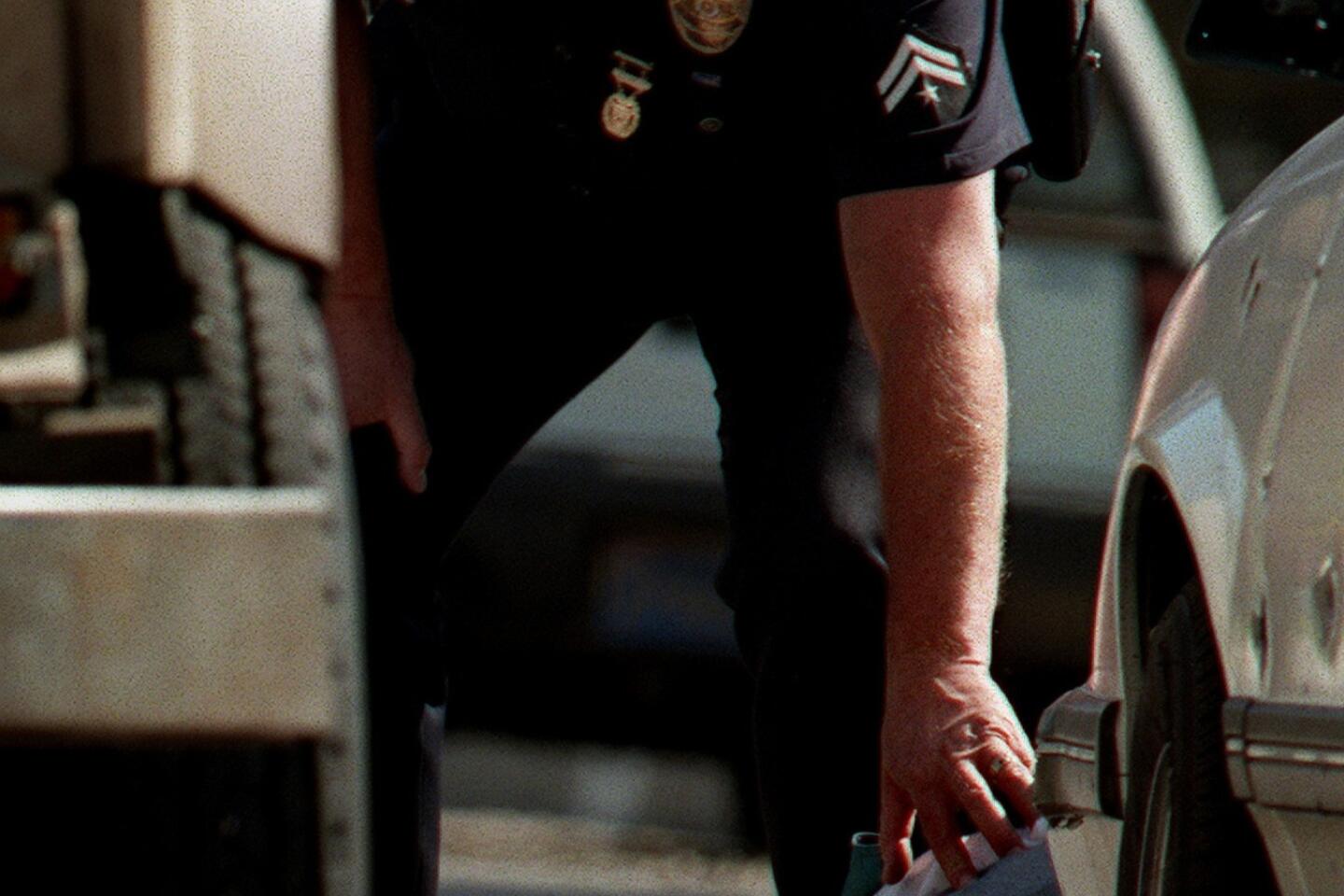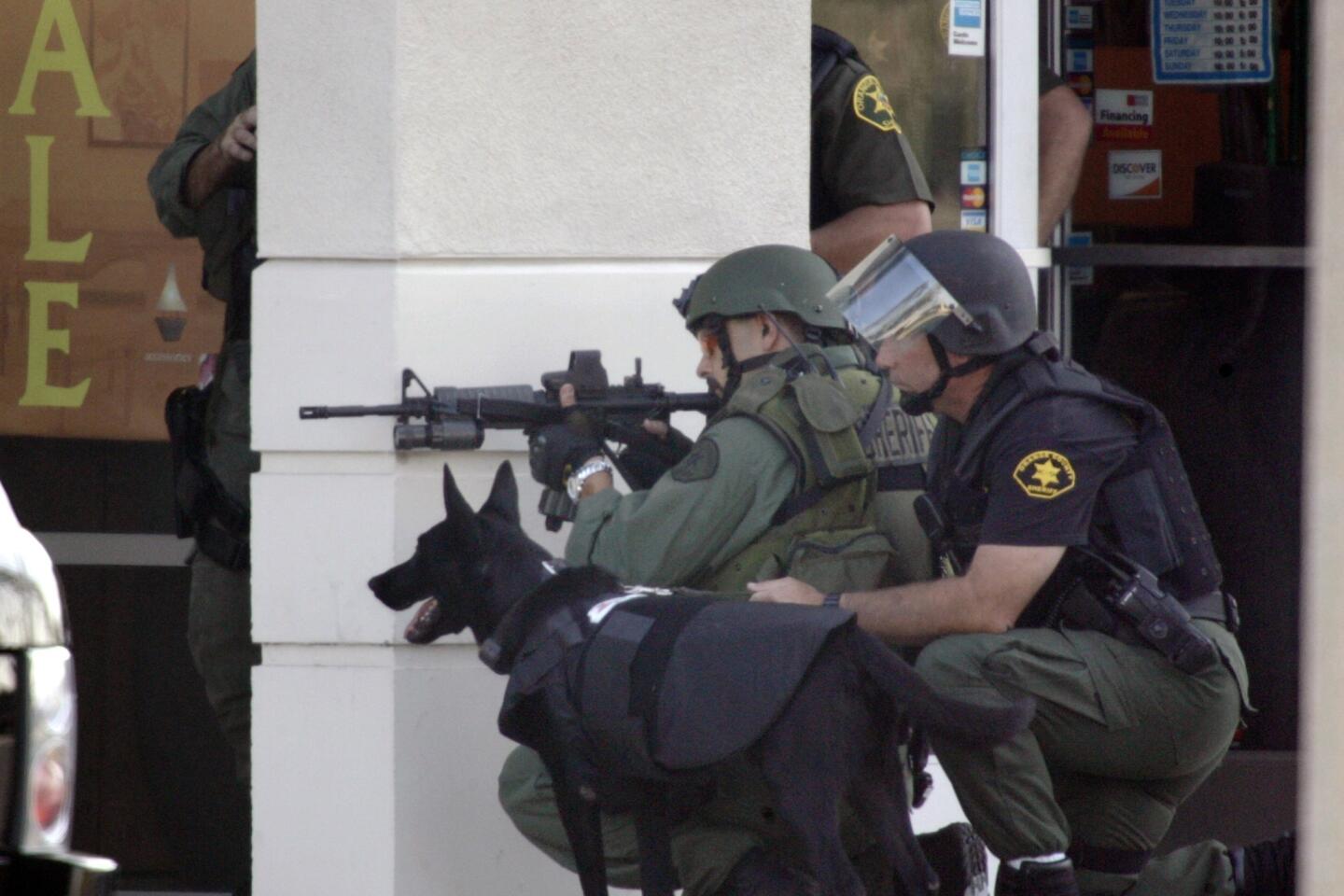Where did all the bandits go?
For decades, Southern California was the undisputed capital of bank robbery.
When five Bank of America branches were robbed in under an hour, an FBI agent shrugged and called it “just another day in L.A.” It was fodder for national news and Hollywood scripts, and the FBI field office had “Bank Robbery Capital of the World” emblazoned on its fax cover sheets. In 1992, the worst year, as many as 28 Los Angeles banks were robbed in a single day.
Then the number of robberies began falling, part of an overall trend that has seen crime rates plummet across the country.
PHOTOS: Well-known Southland bandits
Now, half a century after this newspaper reported that the region was “Getting Title of Bank Holdup Capital” in 1963, the long-standing reign is fizzling to an end.
The seven-county region covered by the FBI’s L.A. office saw a mere 212 bank robberies in 2013, reaching a low not seen since the 1960s. That’s less than a tenth of what it was at its height in the early ‘90s, when the region logged 2,641.
The numbers have gotten so low, in fact, that for the first time in recent memory, the San Francisco region — with less than half the population — had more bank robberies last year, with 227. Other regions have also edged ahead of Los Angeles in recent years, including Atlanta. Compare that to 1983, when L.A. had more bank robberies than the next four regions — New York, San Francisco, Portland, Ore., and Sacramento — combined.
“I was flabbergasted when we broke 400. Then we broke 300,” said special agent Stephen May, the bureau’s bank robbery coordinator in Los Angeles. Considering the region’s 19 million people and 4,500 financial institutions, the per capita rate of bank robberies is even lower, May said.
Just as authorities struggled to explain the sharp rise in the 1980s and 1990s — The vast network of freeways? The booming population and number of banks? Availability of weapons on the streets in the wake of the L.A. riots? — there doesn’t appear to be a singular explanation for the steady decline.
Technology is certainly high on the list. Agents used to pull 35mm film from security cameras and have it developed, hoping for a fleeting, grainy image of the bandit. Nowadays, driving to the scene of the heist, investigators get high-resolution photos e-mailed to them on their smartphones in a matter of minutes. And the Internet makes disseminating the images to the public far faster and easier than relying on the evening newscast.
Beefed-up security measures at banks, including bulletproof plexiglass “bandit-barriers,” have made it harder for robbers to get access to cash and tellers. Convicted robbers are also getting heftier sentences, largely because of firearm enhancements as well as California’s three-strikes law. Under federal law, each count of bank robbery carries a statutory maximum of 20 years, and 25 years for armed robbery.
Lengthy prison terms mean fewer career robbers like William Vance Turner, who robbed his first bank in 1981 and later served prison time for a series of robberies in the ‘90s, earning him the nickname the Pershing Square Bandit. Barely a year after his release, he was back to holding up banks — this time wearing a hat that got him dubbed the Goofy Hat Bandit. In 2009, he was sentenced to 16 years in prison after pleading guilty to his latest string of robberies.
“We had a revolving door,” said former agent Bill Rehder, who supervised bank robbery investigations in L.A. for two decades before retiring in 1999.
Another factor may be that would-be robbers are reconsidering whether hitting a bank is worth the effort. In 2003, the average heist in the U.S. yielded more than $10,000. In 2011, the last year the bureau published national statistics, the average haul was just over $7,500. A nonviolent heist in which the perpetrator uses a note most often yields less than $1,000, investigators say, and one in 10 robbers walks away empty-handed.
The sums from traditional robberies seem particularly paltry compared to the loot in the growing number of cyber heists, in which hackers swipe millions on their keyboards without ever setting foot in a bank.
That doesn’t mean people don’t keep trying. The cast of characters who robbed Southern California banks in 2013 included thieves authorities nicknamed the Button-down Bandit, the New Hat Bandits, the Purse Packing Bandit and the Boom Boom Bandit — a man so named for showing the teller what looks like a homemade explosive and a note: “No drama, no boom boom.”
In one case, an assistant bank manager strapped on a fake bomb and robbed her own bank in cahoots with her boyfriend. In another, an innovative crew carved their way into banks through the roof. Those five men were arrested last year, power saw and ladder in hand, after they had cut through the concrete roof of a Citibank in Diamond Bar — in what investigators believe was at least the fourth hit by the gang since 2011.
All five have pleaded guilty and await sentencing this June.
Despite being a crime with one of the highest clearance rates — about 60% end in arrests in any given year — there are still robbers who elude capture. May is personally most troubled by the AK-47 Bandit, a stocky man standing 5 feet 10 who is wanted for robberies in California, Idaho and Washington. In 2012, after robbing a Chino bank with an assault rifle, he shot at and seriously wounded a patrol officer.
With the decrease in bank robberies, the FBI’s L.A. office has disbanded the squad of agents it once had devoted to investigating them. Now they are investigated by agents in the violent crime squad.
It’s a dramatic change from the old days, says Rehder, the retired longtime agent.
“It was the most action-packed squad we had,” recalled Rehder, who created the fax cover sheets and still drinks out of a coffee mug he designed, with a cartoon bandit and the words “Bank Robbery Capital of the World” in red across the bottom. “I got as big an adrenaline pump out of [investigating] as these guy do planning and pulling off robberies.”
In his memoir, “Where the Money Is: True Tales from the Bank Robbery Capital of the World,” he wrote that as long as there are piles of money, there will be those wanting to steal it. “Any lawman who thinks he can fundamentally change that is looking for a broken heart, and a bitter retirement,” he wrote.
PHOTOS: Well-known Southland bandits
L.A.’s decline in bank robberies, he said in an interview, “definitely has exceeded my expectations.” The dubious honor will probably be passed from city to city depending on the year, said Rehder, who has consulted for banks and acted as an expert witness since his retirement.
“We’d been the bank robbery capital for such a long run, now it’s passed on to others,” he said. “And quite frankly, they’re welcome to it.”
More to Read
Sign up for Essential California
The most important California stories and recommendations in your inbox every morning.
You may occasionally receive promotional content from the Los Angeles Times.














